Huge Vintage Southwestern Native American Signed Ceramic Tile Inlay Wall Mount
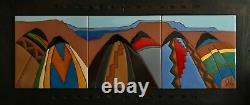
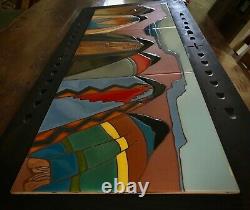
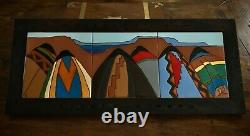
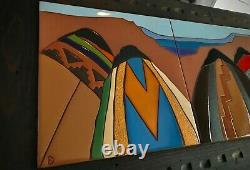
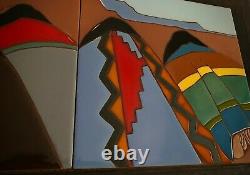
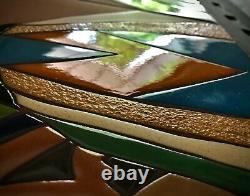
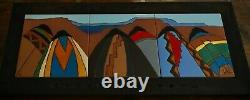
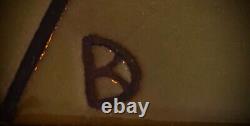
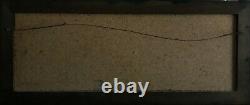

This is, quite frankly, one of the most stunning displays of authentic Native American art I have come across in my 40 some years as a collector. First and foremost, simply in style alone (a hand painted ceramic tile wall mount) this piece is undeniably a hard find. I have seen possibly hundreds of exquisite painted ceramic Native American pots through the years - but prior to coming across this piece, I'd never before seen a painted ceramic tile display.
I find this artistic medium to be absolutely mesmerizing, yet I've had trouble finding anything remotely similar for sale online, or otherwise. A little backstory on this piece. At the time, Santa Fe was in the midst of a Native American cultural arts and jewelry obsession.Twice, sometimes three times a year - the city of Santa Fe put on Native American Cultural Arts and Jewelry Expos - which at the time drew some of the best of the best in the Native world Calvin Martinez, Wilbert Benally, etc. I often refer to this time in my life living in Santa Fe as the "golden years, " as it was during this time that I acquired arguably my most stunning, original pieces (many of which I still own today). Back then, in order to get a booth into a Native American Cultural Arts and Jewelry Expo in Santa Fe, you had to be of Native origin. This requirement truly made those late 80's expos IMMENSELY valuable to a collector such as myself.
It, in essence, weeded out the garbage. No offense to Native imitators - while some works of imitation art serve to pay tribute to the cultural traditions they seek to capture, other imitations are more of a disservice, cheaply thrown together and poorly constructed. The artist had a relatively small booth, yet - I had to fight to make my way through captivated onlookers to get my first glance of this stunning piece. It was the vibrant colors that first caught my eye - reds, blues, purples, browns, yellows, blacks, tans, etc.
It was as though I was peering through a kaleidoscope! It was not just the color used that captivated me, however, but also the way in which those colors were arranged.To sum up the display from the standpoint of color - the word that comes to mind is balance. I initially though I was looking at a high gloss painting - perhaps an acrylic of some sort - over wood. Upon closer inspection, I realized that the hanging display was a work of ceramic tile! I've always been drawn to ceramic tile to begin with. While painting alone takes talent and skill, manipulating ceramic tile to achieve a desired artistic effect is INCREDIBLY difficult to do, as the tile has to be shaped, etched, and filled to successfully convey a chosen design.
What an incredible artistic expression of a mountainscape. Perhaps most stunning, in my opinion, is the artists ability to create depth on a 2-Dimensional ceramic tile medium. In order to do this, the artist carefully manipulates that of color.
Look closely at the middle ground, and background. The furthest mountainous plateaus are a light, faded blue.
Ever stare at a mountainside way off in the distance? Think about how it appears "hazy, " almost dulled by the sheer amount of space between you (the viewer) and the mountain itself. Furthermore, take note of the deeper colors used to depict plateaus that are getting closer and closer to the color. Their increasingly deep colors give the mountainsides more "solid" forms - as they become more and more visible. At the middle ground, the artist uses a deep brown to depict the mountainous plateau, why?
Well - because he understands how to convey depth. This mountain peak is left brown, as it is quite close to the viewer - it isn't "hazy" or "distant, " it is right out in front of you - clearly visible in its solid form. Of course, the star of the show when it comes to this ceramic painted tile display is the foreground. Viewing the foreground, in juxtaposition to the background - showcases the artistic brilliance of the display. The artist wanted you to "get the picture" so to speak that he is conveying a Southwestern mountainscape - thus, the middle ground and background are clearly representative of real world, accurately depicted rising plateaus.
Because this piece is clearly recognizable in its depiction in the middle ground, and background, this gives the artist freedom of artistic expression at the foreground. While these peaks at the front might resembles mountains, they are BEAUTIFULLY and magically composed. Each of the peaks boasts a traditional Southwestern Native American pattern - this pattern intricately carved into the ceramic itself and then filled in thick, black color.While the middle ground and background are monotone in color, the peaks at the front truly cover the spectrum! The contrast created therein nothing short of mesmerizing... What a stunning, unique, and masterful way to work his culture into the piece. Thus, a "worldly" scene of a Southwestern Mountainscape is made an "otherworldly" one... This piece depicts more than just scenes of nature - it depicts the seamless tie between that of Native American Culture, and nature itself.
The artist signed his work "DB" in a very unique way (the B being actually inside of the D). He (and his wife who did the woodwork for the ceramic tile inlays) were of Navajo ethnicity. Their son also had a booth at the Santa Fe Native American Cultural Arts and Jewelry Expo in Santa Fe for years - he made almost exclusively jewelry with heavy use of turquoise and red coral inlay. Weighing in at around 14.8 POUNDS. Including Wooden Frame (34 Inches Length, 14.5 Inches Height, 1.25 Inches Thick).
29.5 Inches Length, 10 Inches Height. Overall, this is a one of a kind piece - and one that is VERY close to the heart. I debated for some whether or not to list, but I ultimately decided to keep this piece cooped up - for only my eyes to see - is wrong. My hope is that it goes off to another family, where it can be passed along for years to come.I will get back to you promptly. The item "Huge Vintage Southwestern Native American Signed Ceramic Tile Inlay Wall Mount" is in sale since Thursday, August 13, 2020. This item is in the category "Collectibles\Cultures & Ethnicities\Native American\ US\1935-Now\Pottery". The seller is "nae_mud_1iupyzywe" and is located in Chagrin Falls, Ohio. This item can be shipped to United States.
- Handmade: Yes
- Modified Item: No
- Country/Region of Manufacture: United States
- Material: Mosaic Tile
- Culture: Native American: US
- Artisan: DB
- Origin: Navajo
- Tribal Affiliation: Navajo

